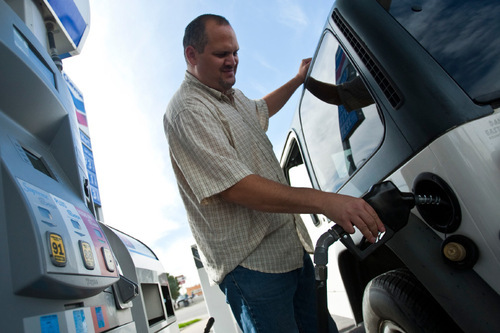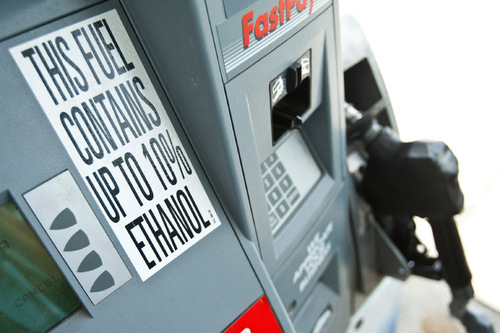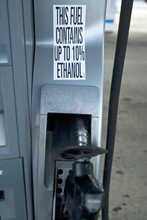This is an archived article that was published on sltrib.com in 2010, and information in the article may be outdated. It is provided only for personal research purposes and may not be reprinted.
Unless you have a penchant for reading gasoline station signs, you probably haven't noticed that you've been pumping ethanol into your gas tank.
For several months now, signs have been posted at pumps saying the gasoline contains up to 10 percent ethanol, a renewable fuel made from various plant materials, mainly corn.
Nearly half of all gasoline sold nationally — and in Utah — contains low levels of ethanol to cut air pollution and reduce U.S. dependency on oil imported from hostile nations.
"Any station that sells gasoline blended with ethanol must post signs indicating its presence," said Larry Lewis, spokesman for the Utah Department of Agriculture and Food. "Our department continues to monitor the presence of ethanol in fuels and to assure correct signage is in place at the pump."
Armitha Quintero was surprised when an ethanol sign was pointed out to her at a Salt Lake City gas station.
"I have no idea what it means," she said as she filled her tank. "But now that I've seen [it], I'll find out more about this ethanol thing."
There are varying opinions on the benefits of using ethanol, said Lewis.
Some researchers say ethanol reduces engine heat and increases octane, as well as provide lower carbon monoxide and carbon dioxide emissions. But other sources report that ethanol may reduce vehicle miles per gallon by about a one-half of a percent to 3 percent, and that ethanol acts like a solvent, dislodging particles that could clog fuel filters.
Most vehicles should not require any adjustment when using a blend of 10 percent ethanol, a level known as E-10. But RV and boat owners should consult dealers or mechanics before using an ethanol blend.
Boats built before the mid-1980s may be at risk for mechanical problems, said Lewis. As a precaution, carry extra filters when boating in case plugging becomes a problem. And use a fuel additive during periods of extended storage.
Currently, the Obama administration is considering whether to raise the percentage of biofuels mixed with gasoline from 10 percent to 15 percent. Motorists must have a "flex-fuel" vehicle to use gasoline with an ethanol content greater than 10 percent. But this may change if research indicates that higher volumes of ethanol can be used without damaging other vehicles' fuel systems.
By the end of November, the U.S. Energy Department is expected to wrap up tests examining whether an increase in ethanol would have any detrimental effects on car engines and emissions systems. And if E-15 is approved quickly, the fuel at that level could be widely available by the beginning of the year, say federal officials.
Ethanol
Nearly half of all gasoline sold in the U.S. is blended with ethanol, a renewable fuel made from plant materials. The federal government has classified low-level blends, up to E-10 (10% ethanol, 90% gasoline), as "substantially similar" to gasoline. Such fuels legally can be used in any gas-powered vehicle.
Source: U.S. Department of Energy. —
Government-driven initiative
Initially, the growth in ethanol was driven by federal legislation aimed at reducing air pollution.
For 13 years beginning in early 1992, motorists in Utah County were required to use fuel containing 2.7 percent oxygen, from Nov. 1 to the end of February. The rule was imposed to reduce carbon-monoxide concentrations each winter when the county frequently exceeded federal clean-air standards.
Refineries had been required to mix an additive — either ethanol or a chemical known as MTBE, an oxygen-rich butane derivative — into gasoline to reach the prescribed oxygen levels. The costs, about 5 cents per gallon, were passed along to consumers.
In 2004, Utah County met air quality standards because newer cars had the technology to burn fuel more efficiently. Oxygenated fuel was no longer needed.
Now, ethanol-blended fuel is back.
The Energy Policy Act of 2005 called for 7.5 billion gallons of renewable fuel to be used by 2012. The Energy Independence and Security Act of 2007 raised the standard, requiring 36 billion gallons of annual renewable fuel use by 2022. Amendments under the Energy Independence Act called for the use of ethanol even in areas with lower air pollution.
Dawn House









